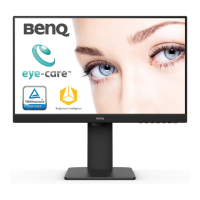
Do you have a question about the BenQ GW2485TC and is the answer not in the manual?
| Screen Size | 23.8 inches |
|---|---|
| Resolution | 1920x1080 (Full HD) |
| Panel Type | IPS |
| Refresh Rate | 75 Hz |
| Aspect Ratio | 16:9 |
| Brightness | 250 cd/m² |
| Contrast Ratio | 1000:1 |
| Response Time | 5 ms (GtG) |
| Connectivity | HDMI, DisplayPort, VGA, USB-C |
| VESA Mount | 100 x 100 mm |
| Viewing Angle | 178°/178° |
| Color Gamut | 72% NTSC |
| Built-in Speakers | Yes |
| Features | Flicker-Free, Low Blue Light, Brightness Intelligence |
| Power Consumption | 18W (Typical) |
Instructions for initial setup and powering on the monitor.
Steps for assembling the monitor stand and base.
Guidance on adjusting the monitor's tilt and swivel.
Instructions for mounting the monitor on a wall.
Instructions for using the monitor's built-in microphone.
Guide to connecting multiple monitors using MST for expanded screen space.
Explanation of how to navigate and use the On-Screen Display menu.
Guidance on proper cleaning methods for the monitor screen.
Instructions for storing the monitor when not in use.
Information on how to get additional product support.
Essential safety instructions for monitor power usage and handling.
Safety guidelines for handling the remote control.
Important notices regarding battery usage and disposal.
Diagram and labels identifying front panel components.
Diagram and labels identifying rear panel ports and connections.
Step-by-step instructions for attaching the monitor base to the stand.
Instructions for connecting HDMI, DP, and USB-C cables.
Guidance on connecting headphones to the monitor's audio jack.
Steps for connecting the monitor's power cable to the outlet.
Steps to prepare the monitor and workspace for stand detachment.
Procedure for detaching the monitor stand from the display.
Instructions for detaching the monitor base from the stand.
How to rotate the display orientation to portrait mode via software.
Steps to extend and tilt the monitor for safe rotation.
Physical rotation of the monitor to portrait orientation.
Important safety and preparation guidelines for wall mounting.
Procedure for detaching the monitor stand for wall mounting.
Steps to remove screws from the monitor's back cover.
Guidance on using the purchased wall mount bracket for installation.
Identification and function of the monitor's control buttons.
Controls for automatic brightness adjustment using a light sensor.
Displays ambient light conditions on the screen.
Adjusts the sensitivity of the light sensor for detection.
Adjusts color perception for users with color vision deficiencies.
Selects audio equalizers for different scenarios.
Configures microphone status, volume, and noise cancellation.
Assigns functions to the monitor's rotation keys.
Assigns functions to the monitor's custom key.
Configures OSD language, display time, and lock settings.
Automatically adjusts contrast for optimal visual signal distribution.
Automatically detects available input sources.
Enables or disables USB-C power delivery in standby mode.
Enables data transmission for multiple daisy-chained monitors.
Improves the gray level response time of the LCD panel.
Selects color scale range for connected HDMI devices.
Sets the time to power off the monitor in power saving mode.
Sets display of resolution recommendations for new input sources.
Displays current monitor property settings and model name.
Resets all mode, color, and geometry settings to factory defaults.
Common issues and their solutions, categorized by problem type.
Troubleshooting steps for blurred, distorted, or pixelated images.
Interpreting the monitor's power LED status lights.
How to access and unlock the On-Screen Display controls.
Understanding and resolving OSD messages like 'Out of Range'.
Diagnosing issues with the monitor's light sensor.
Troubleshooting steps for the Multi-Stream Transport (MST) function.